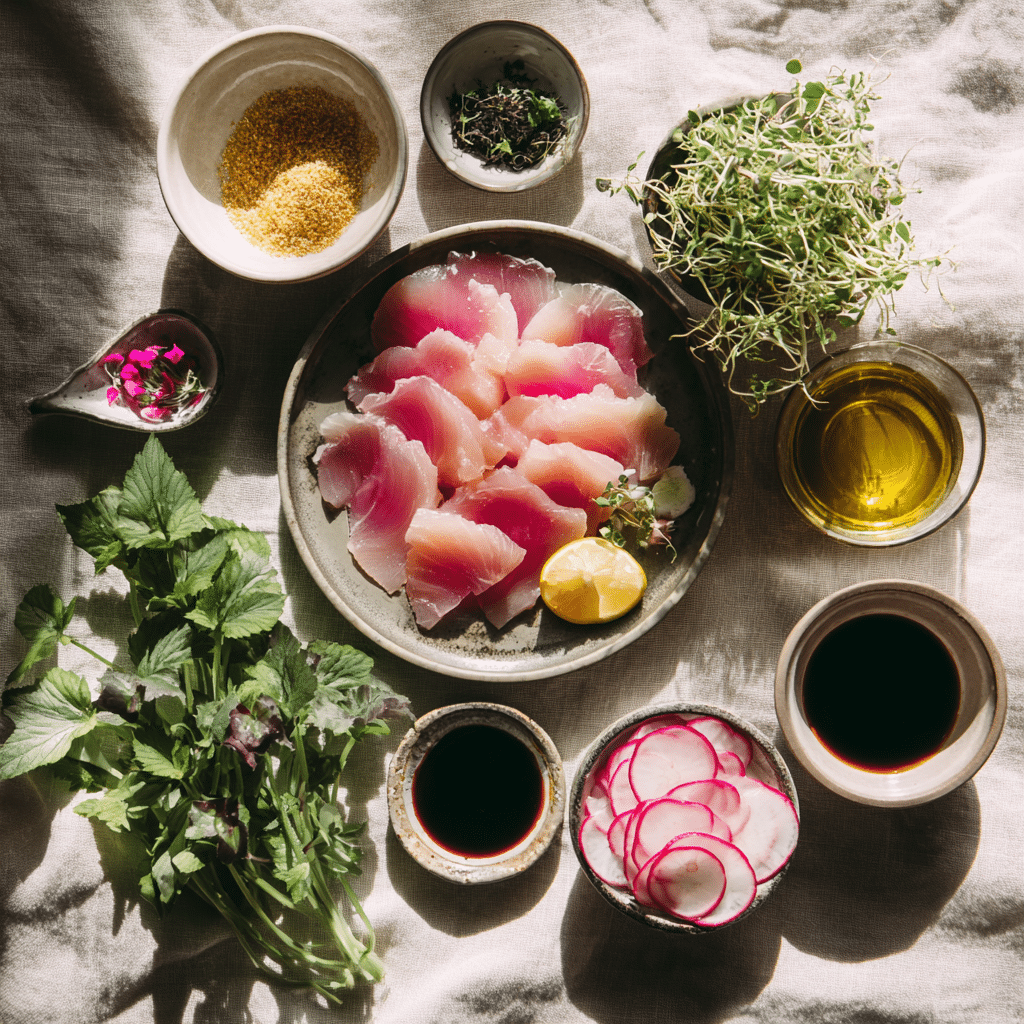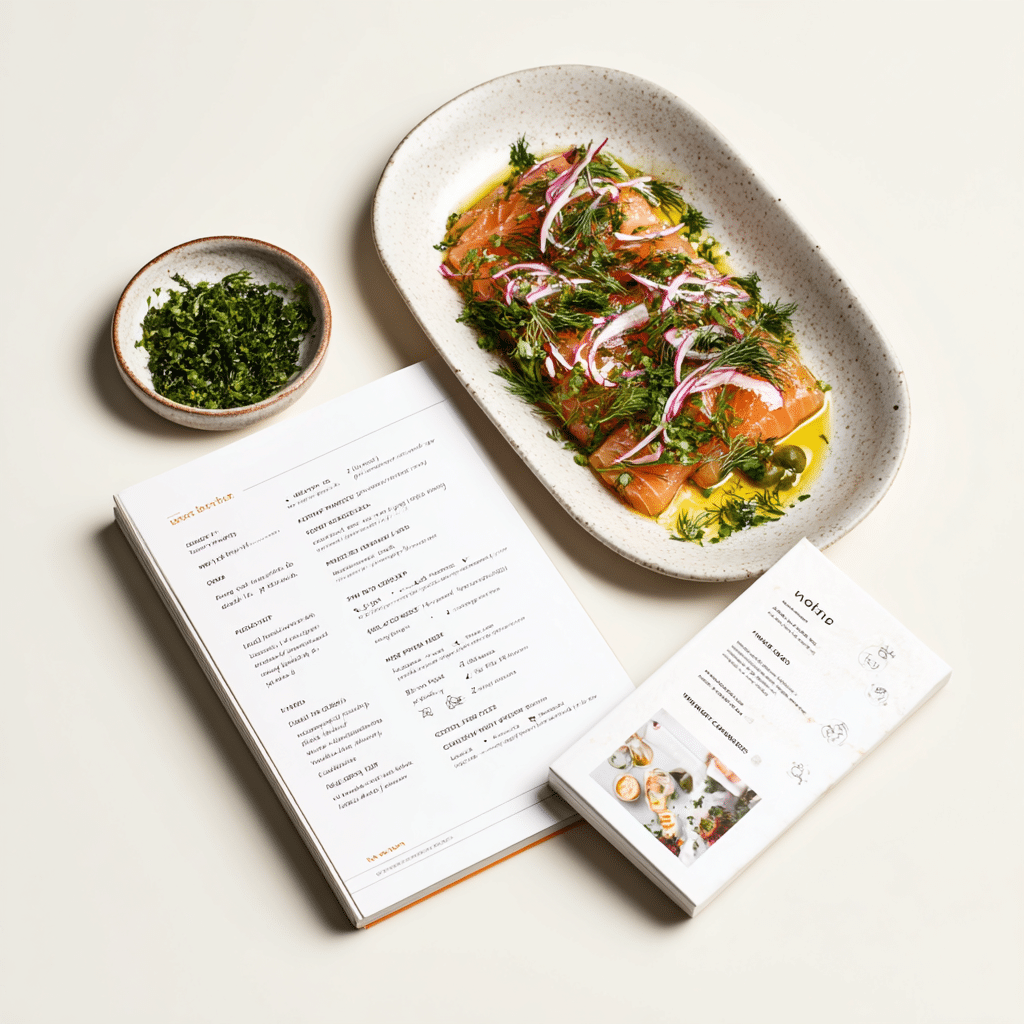Sometimes, a dish just stops you in your tracks. For me, that moment happened at a tiny beachside izakaya in Maui. The sun was slipping behind the waves, and a cool plate of kanpachi carpaccio recipe landed in front of me—thin slices of amberjack glistening under a whisper of ponzu and sesame oil, topped with the crunch of fried leeks and the brightness of citrus. I took one bite and knew this wasn’t just food—it was art.
That memory stuck with me. Back home in Oregon, I couldn’t shake the idea of recreating that exact kanpachi carpaccio recipe. But here’s the thing: I’m not a trained chef. I’m just someone who loves to cook and connect through food. So, I started experimenting. I learned how to source sushi-grade kanpachi, how to slice it properly, and how to balance flavors in a way that respected the fish. And you know what? This kanpachi carpaccio recipe became one of my favorite go-to starters—especially in warmer months when I want something fresh, light, and full of flavor.
This article will walk you through everything you need to know about making a kanpachi carpaccio recipe at home, whether you’re a sashimi lover or just curious about Japanese-Italian fusion. From choosing your fish to plating like a pro, you’ll get real kitchen-tested tips that don’t require a culinary degree—just a love of simple, beautiful food.
Print
Kanpachi Carpaccio Recipe: Simple, Refreshing & Packed With Umami
- Total Time: 15 minutes
- Yield: 2 servings 1x
Description
A light and elegant kanpachi carpaccio recipe made with ponzu, sesame oil, and fresh garnishes. Perfect for a quick appetizer or light meal.
Ingredients
6 oz sushi-grade kanpachi, thinly sliced
2 tbsp ponzu sauce
1 tsp toasted sesame oil
1/4 tsp yuzu kosho or fresh grated ginger
2 radishes, thinly sliced
A few microgreens or shiso leaves
Sea salt or pink peppercorn (optional)
Instructions
Chill the kanpachi fillet in the freezer for 10 minutes.
Using a very sharp knife, slice the kanpachi into 1/8-inch slices.
Arrange the slices on a chilled plate in a circular or fan shape.
Whisk together ponzu, sesame oil, and yuzu kosho.
Drizzle the sauce lightly over the fish.
Top with radish, microgreens, and optional seasonings.
Serve immediately with chopsticks or small forks.
Notes
For best results, use very fresh sushi-grade kanpachi.
Keep the plate and fish cold to preserve texture and flavor.
You can substitute ponzu with a mix of soy sauce, lemon juice, and rice vinegar.
- Prep Time: 15 minutes
- Cook Time: 0 minutes
- Category: Appetizer
- Method: No-Cook
- Cuisine: Japanese Fusion
Nutrition
- Serving Size: 1 plate
- Calories: 180
- Sugar: 1g
- Sodium: 420mg
- Fat: 11g
- Saturated Fat: 1.5g
- Unsaturated Fat: 8g
- Trans Fat: 0g
- Carbohydrates: 2g
- Fiber: 0g
- Protein: 18g
- Cholesterol: 35mg
Keywords: kanpachi carpaccio recipe, raw fish, crudo, sashimi
Table of Contents
A Slice of Summer: My First Taste of Kanpachi Carpaccio
I still remember how the kanpachi practically melted on my tongue that first time. It had none of the heaviness of tuna, nor the overpowering oiliness you sometimes get with mackerel. It was buttery, clean, and subtly sweet—made even better by the tartness of ponzu and the grassy freshness of shiso.
Back home, I searched online for a good kanpachi carpaccio recipe, and quickly realized there were dozens of interpretations. Some leaned classic Italian, using olive oil and capers. Others took a bolder route with miso aioli or yuzu kosho. But what they all had in common was a deep respect for the main ingredient: the fish.
Over the months, I played with different flavor combinations and techniques. I found that sesame oil, soy, and citrus brought out kanpachi’s best qualities. A few fried shallots or scallions on top gave a perfect contrast in texture. Eventually, I created a version that’s as close as I can get to that first magical bite—and now I’m sharing it with you. If you’ve never tried a kanpachi carpaccio recipe before, don’t worry. This one is beginner-friendly.
If you’re new to crudos or sashimi-style dishes, don’t stress. This kanpachi carpaccio recipe doesn’t ask for fancy tools or hard-to-find ingredients. It’s all about sourcing the best fish you can and treating it with care. The technique is easy, and the results feel like something you’d order at a high-end sushi bar—without ever leaving your kitchen.
Why This Recipe Works Anytime, Anywhere
Here’s why this dish has become a staple in my kitchen: it’s fast, it’s fresh, and it feels a little special—even if I’m just making it for myself on a Wednesday night.
There’s no cooking involved, which makes it ideal for summer or anytime you want to avoid heating up the stove. The fish is served raw and chilled, so it’s naturally refreshing. The dressing takes seconds to whisk together, and you can customize it based on what’s in your pantry. Whether you go traditional with ponzu and sesame or switch things up with a miso-lemon blend, the flavors will sing.
The beauty of a kanpachi carpaccio recipe is that it’s endlessly adaptable. Hosting friends? Plate it on a big platter and let everyone dive in. Cooking for one? Slice a few pieces, dress them lightly, and enjoy with a glass of crisp white wine or cold sake. Want to turn it into a light lunch? Add avocado slices or serve it over mixed greens.
What makes this dish stand out is how it celebrates quality ingredients. You don’t need a dozen elements or complicated sauces. Just clean, vibrant flavors that let the kanpachi shine. If you’ve ever made sashimi at home or enjoyed crudo at a restaurant, you’ll appreciate how simple and satisfying this version is.
For more light, Asian-style recipes that come together quickly, you might enjoy my spicy tuna rice bowl or this refreshing cucumber sunomono salad—both make great accompaniments to this kanpachi carpaccio recipe.
Ingredients & Prep Tips
The Freshest Fish Wins: Choosing Your Kanpachi
The first—and most important—step in making a great kanpachi carpaccio recipe is choosing the right fish. Kanpachi, also known as amberjack, is prized for its clean, rich flavor and firm texture. It’s a favorite in Japanese cuisine, especially for sashimi. While some folks substitute hamachi, kanpachi has a milder, slightly sweeter profile that makes it ideal for raw preparations like carpaccio.
When shopping, look for sushi-grade kanpachi. This label means the fish was frozen immediately after harvest to kill any parasites, making it safe to eat raw. You’ll usually find it at Japanese or high-end seafood markets. If you’re ordering online, choose a reputable supplier that ships it flash-frozen and vacuum-sealed.
Here’s a quick comparison that might help you decide:
| Feature | Kanpachi | Hamachi |
|---|---|---|
| Texture | Firm, slightly buttery | Softer, more oily |
| Flavor | Clean, mild, slightly sweet | Rich, strong |
| Best Use | Carpaccio, crudo, sashimi | Sushi rolls, grilling |
When you’re ready to prepare your kanpachi carpaccio recipe, make sure your knife is razor-sharp. A dull blade will tear the flesh instead of slicing cleanly. Slice against the grain, aiming for pieces about 1/8 inch thick. Keep them uniform for a better mouthfeel and presentation.
If you’re nervous about slicing raw fish at home, freeze the fillet for 10–15 minutes to firm it up. This makes thin slicing much easier. Just don’t let it freeze solid—you’re not making ice fish.
Pantry Essentials That Make the Dish Sing
A good kanpachi carpaccio recipe doesn’t need a dozen ingredients. In fact, the fewer, the better—as long as each one brings something to the table. The goal is to highlight the kanpachi, not bury it.
Here are the core ingredients I use again and again:
- Ponzu sauce – This citrus-soy sauce adds tang and umami. I usually keep a bottle on hand, but homemade ponzu is easy too (just mix soy sauce, rice vinegar, lemon or yuzu juice, and a splash of mirin).
- Sesame oil – A few drops go a long way. Use toasted sesame oil for nutty richness.
- Fine sea salt or flaky salt – This finishes the dish with clean, crisp bursts of flavor.
- Shiso leaves or microgreens – Shiso adds a minty-basil note that plays beautifully with kanpachi. Microgreens are a great substitute.
- Radish, daikon, or cucumber – Thinly shaved for crunch and brightness.
- Optional extras: chili oil, yuzu kosho, pickled ginger, or even avocado slices.

If you can’t find ponzu or shiso, don’t stress. A light drizzle of soy sauce mixed with lemon juice will work in a pinch. And if you want something creamy and bold, try a miso-lemon aioli instead.
Looking to stretch the dish a little? Lay the slices over a bed of lightly dressed greens and call it a salad. Or serve with cold soba noodles tossed in sesame oil and scallions, like in this easy soba bowl recipe from my site.

When building your version of this kanpachi carpaccio recipe, keep it simple. Trust the fish. Trust your taste buds. You’ll know when it’s just right.
Flavor Profiles & Plating Magic
From Citrus to Umami: Dressing That Delivers
The heart of any kanpachi carpaccio recipe lies in the balance of its dressing. Kanpachi is buttery and mild, so the sauce needs to enhance its clean flavor—not overwhelm it. Whether you’re going bright and citrusy or rich and creamy, you want to strike that perfect harmony.
A classic route starts with ponzu, a tangy soy-based sauce with citrus. Add toasted sesame oil for warmth and a touch of grated ginger or yuzu kosho for depth. That’s it. Just a few ingredients, whisked together in seconds.
Here’s a simple formula that works every time:
- 2 tablespoons ponzu
- 1 teaspoon toasted sesame oil
- 1/4 teaspoon yuzu kosho or freshly grated ginger
Drizzle it lightly over the fish right before serving. Let the flavors sit for a minute, then serve.
If you’re looking for a richer spin, try a miso-lemon blend. It’s a great option for swiping across the plate before layering the fish or spooning alongside each bite.
- 1 tablespoon white miso
- 1 tablespoon lemon juice
- 1 tablespoon neutral oil
- 1/2 teaspoon honey or mirin
Blend until creamy. This dressing adds umami and a subtle sweetness to your kanpachi carpaccio recipe, especially when paired with crunchy garnishes like radish or pickled daikon.
If you’re in the mood to improvise, even a leftover citrus ginger vinaigrette works. I’ve used it myself, and it delivered a beautiful brightness. That’s what makes this dish special—once you learn the base, it welcomes creativity.
Just remember: the best dressing doesn’t cover the fish. It highlights it. Less is more.
Plate Like a Pro Without the Fuss
Plating this dish should feel easy and enjoyable. A great kanpachi carpaccio recipe doesn’t need complicated tools—just a cold plate and a light hand.
Start by arranging the fish slices in a gentle circle or fan. Slight overlap is fine, but give the fish space to shine. This layout makes the presentation elegant but relaxed.
Spoon the dressing lightly across the top. You want just enough to coat each piece. Then come the garnishes: thin slices of cucumber or radish for crunch, microgreens or shiso ribbons for freshness, and maybe a pinch of sea salt or pink pepper for a pop.
Want a little texture? Try fried leeks or shallots. A single drop of chili oil in the center also adds color and just the right heat. These details give your kanpachi carpaccio recipe that “restaurant look” without overdoing it.
I love brushing the plate with dressing before placing the fish. It’s simple and elevates the whole visual feel. A chilled white plate makes everything pop, but slate gray or matte black also creates beautiful contrast.
If you’re making this part of a meal, pair it with something light and nutty like my cold sesame soba salad. The combo brings balance to the table and rounds out the experience.
Presentation doesn’t have to be fussy. The magic of a well-plated kanpachi carpaccio recipe is how effortless it looks. The fish is already the star. All you’re doing is setting the stage.
Serve & Customize
When to Serve It & What Pairs Well

A good kanpachi carpaccio recipe doesn’t need a fancy occasion. In fact, it’s one of those dishes that makes any moment feel special. Light, cool, and flavorful—it’s perfect for sunny evenings, quiet lunches, or laid-back gatherings.
Serve it as a starter alongside a glass of crisp white wine or chilled sake. Its clean flavor pairs nicely with fresh vegetables, steamed edamame, or even a small bowl of sushi rice.
Want to build it into a full meal? Try laying the fish over a bed of greens, lightly dressed in sesame vinaigrette. Or enjoy it with warming sides like miso-glazed eggplant or a scoop of fluffy white rice and miso soup.
The key is keeping the flavors balanced—light, salty, slightly tangy. When you do that, this dish fits anywhere on the menu.
Make It Yours: Custom Carpaccio Ideas
Once you’ve made a classic version, it’s easy to have fun with your own twist on this kanpachi carpaccio recipe. You can build on the base with new textures, unexpected garnishes, or a different style of dressing.
Here are a few ideas:
- Swap the ponzu for a drizzle of lemon olive oil and sea salt.
- Add diced avocado or thin mango slices for creaminess or sweetness.
- Sprinkle with crispy shallots or sesame seeds for crunch.
- Use thin jalapeño or chili crisp if you like a kick.
You can also change the plating. Stack the fish over cucumber ribbons or lay slices in a star pattern on a slate plate for a dramatic look.
I often keep it minimal—but I love that this recipe is flexible. You can go from Japanese-style simplicity to more modern, creative plating, all with the same base technique. No matter how you serve it, this kanpachi carpaccio recipe will always feel fresh and satisfying.
Conclusion
There’s something deeply satisfying about a well-made kanpachi carpaccio recipe. It’s delicate but rich, elegant but easy, and never takes more than a few minutes to prepare.
You don’t need a professional kitchen or imported ingredients. You just need fresh fish, a light touch, and the willingness to try. Whether you’re serving it as an appetizer or building a full meal around it, this recipe brings a quiet kind of joy to the table.
So next time you’re craving something light, flavorful, and fuss-free—trust this recipe. It might just become a new favorite.
for more recipes follow me in facebook , Home Page
FAQs
What is the cooking technique of carpaccio?
Carpaccio is a no-cook method that uses paper-thin slices of raw fish or meat, served cold and lightly seasoned. Typically, the protein is dressed with oil, citrus, or soy-based sauces to highlight freshness and texture. It’s all about minimalism and balance.
What is kampachi carpaccio?
Kampachi carpaccio is a dish made with kanpachi, a firm and mild-flavored fish, sliced thin and served raw. This version blends sashimi-style slicing with bright garnishes like ponzu, sesame oil, or citrus. A kanpachi carpaccio recipe usually borrows from both Japanese and Italian influences.
How to cut kanpachi sashimi?
Start with a sharp knife and a well-chilled fillet. Cut against the grain at a slight angle, aiming for 1/8-inch slices. This technique ensures clean cuts and keeps the texture tender. It’s the same method used when preparing kanpachi for carpaccio or sashimi.
What is a Japanese carpaccio called?
Often called “kanpaccio,” it’s a playful fusion of kanpachi and carpaccio. The preparation mirrors sashimi but includes sauces and garnishes inspired by Italian or Western cuisine—common in any well-balanced kanpachi carpaccio recipe.




